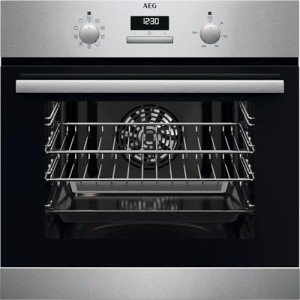
13
JuniTen Single Fan Ovens That Really Make Your Life Better

Understanding Single Fan Ovens: A Comprehensive Guide
Intro
As modern-day kitchen areas grow increasingly sophisticated, devices developed for performance and performance are at the leading edge of consumer interest. One such device that remains popular among home cooks and baking enthusiasts is the single fan oven, an electric model understood for its flexibility and ease of usage. This article supplies thorough info about single fan ovens, including their functionality, advantages, types, and factors to consider for purchase.
What is a Single Fan Oven?
A single fan oven, also known as a stove, includes a single cooking chamber with a fan and exhaust system that circulates hot air consistently throughout the cooking area. This results in an even cooking temperature level and improved cooking effectiveness compared to standard static ovens.
Secret Components of a Single Fan Oven
- Heating Elements: Usually situated at the top and bottom, these generate heat for cooking.
- Fan: The central feature that circulates the hot air within the oven, promoting quicker and more even cooking.
- Thermostat: Regulates the temperature level to make sure ideal cooking conditions.
- Control Panel: Provides interface alternatives for setting temperature levels, cooking times, and modes.
How Does a Single Fan Oven Work?
Single fan ovens operate by combining the heat from the heating aspects with the air motion created by the fan. The hot air is distributed evenly around the food, considerably minimizing cooking time while likewise permitting lower cooking temperature levels.
Advantages of Using a Single Fan Oven
- Faster Cooking Times: The circulating air permits food to cook faster compared to conventional ovens.
- Even Cooking: Food is exposed to constant heat from all sides, reducing the opportunities of unequal cooking or locations.
- Adaptability: These ovens can be used for baking, roasting, and even barbecuing, making them ideal for a broad range of dishes.
- Energy Efficiency: By cooking at lower temperatures and in less time, these ovens may use less energy than their traditional equivalents.
- Moisture Retention: The design assists keep wetness in meals, leading to juicy roasts and baked products with a light texture.
Types of Single Fan Ovens
When thinking about a single fan oven, customers may encounter different types based on functions and design. Here are a couple of common types:
1. Built-in Single Fan Ovens
- Description: Integrated into kitchen cabinetry for a smooth appearance.
- Pros: Saves counter area, aesthetically pleasing.
- Cons: Higher setup costs, may need professional help.
2. Freestanding Single Fan Ovens
- Description: Standalone units that can be put anywhere in the kitchen.
- Pros: Easy to set up, flexible positioning.
- Cons: Can take up more area, may not mix well with cabinets.
3. Range Cookers with Fan Ovens
- Description: Multiple cooking alternatives, including a fan oven, combined in one system.
- Pros: Offers various cooking methods, perfect for ambitious cooks.
- Cons: Generally more pricey, bigger footprint.
Comparison Table of Single Fan Oven Types
| Type | Pros | Cons |
|---|---|---|
| Built-in | Space-saving, aesthetically pleasing | Higher costs, professional setup required |
| Freestanding | Versatile positioning | Uses up more area, might not match kitchen cabinetry |
| Range Cooker | Several cooking methods | Higher price, bigger size |
Choosing the Right Single Fan Oven
When selecting a single fan oven, several aspects must be considered to ensure that it satisfies personal cooking requirements and fits within your kitchen design.
Aspects to Consider
- Size and Capacity: The size needs to complement your kitchen layout while offering enough capacity for your cooking practices.
- Functions and Functions: Look for adjustable racks, self-cleaning choices, and several cooking modes to boost versatility.
- Energy Efficiency: Check for energy rankings; some designs are designed to be particularly energy-efficient.
- Spending plan: Costs can vary considerably, making it crucial to develop a practical budget plan beforehand.
Maintenance Tips for Single Fan Ovens
- Routine Cleaning: Wipe down interior surface areas after usage to avoid residue accumulation.
- Check the Fan: Ensure the fan is devoid of blockages and working correctly.
- Inspect Seals: Regularly examine the door seals for wear and tear to keep cooking performance.
- Expert Servicing: Schedule regular professional checks to guarantee optimal operation.
Frequently Asked Questions about Single Fan Ovens
1. Can I utilize my single fan oven for baking?
Definitely! Single fan ovens are exceptional for baking, supplying consistent temperatures vital for cakes, cookies, and breads.
2. Is it necessary to preheat a single fan oven?
While preheating is normally suggested for optimal results, due to the performance of a fan oven, some recipes may not need it.
3. Can I cook numerous dishes simultaneously?
Yes! The even heat distribution in single fan ovens allows you to bake or roast several dishes concurrently, using all rack levels effectively.
4. Does a single fan oven cook quicker than a conventional oven?
Yes, the fan-assisted heating decreases cooking times, making it possible for much faster cooking.
Single fan ovens offer an exceptional balance of speed, versatility, and effectiveness, making them a valuable addition to any kitchen. Whether for baking, roasting, or daily cooking, these ovens ensure that home cooks can produce delicious meals with ease. By understanding the benefits, types, and factors to consider for buying a single fan oven, consumers can make an informed choice that aligns with their culinary desires and kitchen dynamics.
Accepting the functionalities of a single fan oven certainly paves the way for improved cooking experiences in the modern kitchen.


Reviews